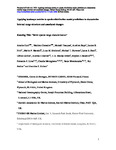Applying landscape metrics to species distribution model predictions to characterize internal range structure and associated changes
| dc.contributor.author | Curd, A | |
| dc.contributor.author | Chevalier, M | |
| dc.contributor.author | Vasquez, M | |
| dc.contributor.author | Boyé, A | |
| dc.contributor.author | Firth, Louise | |
| dc.contributor.author | Marzloff, MP | |
| dc.contributor.author | Bricheno, LM | |
| dc.contributor.author | Burrows, MT | |
| dc.contributor.author | Bush, LE | |
| dc.contributor.author | Cordier, C | |
| dc.contributor.author | Davies, AJ | |
| dc.contributor.author | Green, JAM | |
| dc.contributor.author | Hawkins, SJ | |
| dc.contributor.author | Lima, FP | |
| dc.contributor.author | Meneghesso, C | |
| dc.contributor.author | Mieszkowska, N | |
| dc.contributor.author | Seabra, R | |
| dc.contributor.author | Dubois, SF | |
| dc.date.accessioned | 2023-02-15T20:13:41Z | |
| dc.date.issued | 2023-02 | |
| dc.identifier.issn | 1365-2486 | |
| dc.identifier.issn | 1365-2486 | |
| dc.identifier.uri | http://hdl.handle.net/10026.1/20403 | |
| dc.description.abstract |
<jats:title>Abstract</jats:title><jats:p>Distributional shifts in species ranges provide critical evidence of ecological responses to climate change. Assessments of climate‐driven changes typically focus on broad‐scale range shifts (e.g. poleward or upward), with ecological consequences at regional and local scales commonly overlooked. While these changes are informative for species presenting continuous geographic ranges, many species have discontinuous distributions—both natural (e.g. mountain or coastal species) or human‐induced (e.g. species inhabiting fragmented landscapes)—where within‐range changes can be significant. Here, we use an ecosystem engineer species (<jats:italic>Sabellaria alveolata</jats:italic>) with a naturally fragmented distribution as a case study to assess climate‐driven changes in within‐range occupancy across its entire global distribution. To this end, we applied landscape ecology metrics to outputs from species distribution modelling (SDM) in a novel unified framework. SDM predicted a 27.5% overall increase in the area of potentially suitable habitat under RCP 4.5 by 2050, which taken in isolation would have led to the classification of the species as a climate change winner. SDM further revealed that the latitudinal range is predicted to shrink because of decreased habitat suitability in the equatorward part of the range, not compensated by a poleward expansion. The use of landscape ecology metrics provided additional insights by identifying regions that are predicted to become increasingly fragmented in the future, potentially increasing extirpation risk by jeopardising metapopulation dynamics. This increased range fragmentation could have dramatic consequences for ecosystem structure and functioning. Importantly, the proposed framework—which brings together SDM and landscape metrics—can be widely used to study currently overlooked climate‐driven changes in species internal range structure, without requiring detailed empirical knowledge of the modelled species. This approach represents an important advancement beyond predictive envelope approaches and could reveal itself as paramount for managers whose spatial scale of action usually ranges from local to regional.</jats:p> | |
| dc.format.extent | 631-647 | |
| dc.format.medium | Print-Electronic | |
| dc.language | en | |
| dc.language.iso | eng | |
| dc.publisher | Wiley | |
| dc.subject | climate change | |
| dc.subject | engineer species | |
| dc.subject | landscape metrics | |
| dc.subject | patch dynamics | |
| dc.subject | range fragmentation | |
| dc.subject | species distribution modelling | |
| dc.subject | within-range structure | |
| dc.title | Applying landscape metrics to species distribution model predictions to characterize internal range structure and associated changes | |
| dc.type | journal-article | |
| dc.type | Journal Article | |
| plymouth.author-url | https://www.webofscience.com/api/gateway?GWVersion=2&SrcApp=PARTNER_APP&SrcAuth=LinksAMR&KeyUT=WOS:000888914800001&DestLinkType=FullRecord&DestApp=ALL_WOS&UsrCustomerID=11bb513d99f797142bcfeffcc58ea008 | |
| plymouth.issue | 3 | |
| plymouth.volume | 29 | |
| plymouth.publication-status | Published | |
| plymouth.journal | Global Change Biology | |
| dc.identifier.doi | 10.1111/gcb.16496 | |
| plymouth.organisational-group | /Plymouth | |
| plymouth.organisational-group | /Plymouth/Faculty of Science and Engineering | |
| plymouth.organisational-group | /Plymouth/Faculty of Science and Engineering/School of Biological and Marine Sciences | |
| plymouth.organisational-group | /Plymouth/REF 2021 Researchers by UoA | |
| plymouth.organisational-group | /Plymouth/REF 2021 Researchers by UoA/UoA07 Earth Systems and Environmental Sciences | |
| plymouth.organisational-group | /Plymouth/Users by role | |
| plymouth.organisational-group | /Plymouth/Users by role/Academics | |
| dc.publisher.place | England | |
| dcterms.dateAccepted | 2022-10-04 | |
| dc.rights.embargodate | 2023-11-17 | |
| dc.identifier.eissn | 1365-2486 | |
| dc.rights.embargoperiod | Not known | |
| rioxxterms.versionofrecord | 10.1111/gcb.16496 | |
| rioxxterms.licenseref.uri | http://www.rioxx.net/licenses/all-rights-reserved | |
| rioxxterms.licenseref.startdate | 2023-02 | |
| rioxxterms.type | Journal Article/Review |


